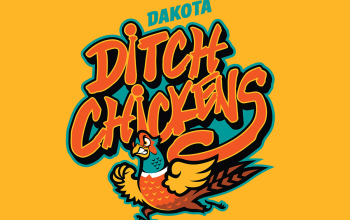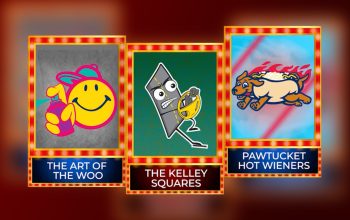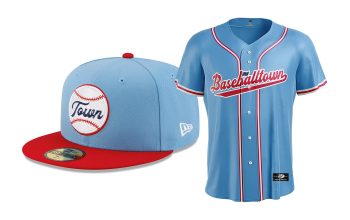
Inside the Cincinnati Reds Hall of Fame and Museum the chief curator, Chris Eckes, Reds staff, folks from MLB and designers from uniform provider Majestic poured over decades-old uniforms. With measuring tapes out, they took precise dimensions of everything from logo sizes to collar widths. They matched colours, looked at materials and dissected every inch of the old garments.
It was all in preparation for one of the grandest uniform throwback plans in professional sports, this year’s Cincinnati Reds celebration of its 150th anniversary of the first professional baseball team, the Cincinnati Red Stockings. The Reds staggered 15 throwback uniforms across weekends of the 2019 season.
“When we deiced to do a certain style, we wanted to get it as close to the original as we possibly could,” Eckes says. “It is incredibly satisfying to see it all come to fruition and I am loving how they look in person and they are translating really well on television. It is very rewarding.”
The Reds kicked off the 15-uniform march through history with a 1902 home version before debuting a popular 1911 road blue. We’ve since seen the 1912 home. Next comes the 1919 home World Series edition.

“It was certainly an evolution of thought,” Eckes says about choosing the final 15. “Once you start talking about 150 years it automatically pushes you to express that range of time the best you can.” The project came about as the museum held a Reds Threads exhibit during discussions of how to celebrate the milestone, allowing Reds staff to latch onto using uniforms as a key pillar of the anniversary, trying to convey the expansive years and long history of the club through style, landmark years and title years.
“It became a compromise in trying to strike a good balance in style differentiation and acknowledging seasons,” Eckes says. And while the 1919 World Series gets honoured, the 1940 win gets a nod from the 1939 uniform that also celebrated the birth of baseball with an interesting patch. “We wanted to show a lot of style difference, but not overlook significant history,” he says. “Sometimes you could cheat and do both.”
The process included the Reds creating a wish list of its uniforms and the actual maker of the on-field garments, Majestic, devising their own list. With a heavy cross-over of the two, they easily aligned them and started pulling what concrete examples they did have, both as a club and from helpful collectors. Majestic was also culled from its archives for uniforms made in the same years. From there it was about measuring logo and number sizes, taking pictures, feeling fabric, getting precise dimensions and sometimes simply diving into newspaper images and clippings describing the designs.

Majestic would then mock up a design, send it back to the Reds and they would offer tweaks. “There was that give-and-take process,” Eckes says. “When we decided to do a certain style, we wanted to get it as close as we possibly could.”
And it worked out every time, except for one. The Reds had hoped to recreate the 1869 style uniform but couldn’t make it work. “We looked at that one up one side and down the other trying to figure out a way to make that work in a way that it could be worn by the club on the field and there didn’t seem to be a good solution to that,” he says. “We would rather not do it than do a pale imitation. For the others, we felt like we could get pretty darn close and I think we did. If we couldn’t pull it off, we didn’t.”
Eckes says logo sizing and collars provided the most significant challenges, especially if the actual uniform wasn’t on hand, forcing them to go back to images to try to make everything proportional. That was seen clearly in the earliest of designs. But having real-life examples on hand allowed the team to overcome a lot of the challenges.

The Reds had physical examples of every one of the 15 uniforms from 1935 on but did need to use a 1920s instance for the 1919 version. “Any time you are trying to take a flat image and turn it into a dimensional garment, there are going to be hurdles there,” Eckes says. “The logo sizing, there is a little bit of guesswork with colour too. You take all the available visual evidence and compare it to the physical examples produced.”
Ultimately, the team was trying to recreate the looks as close to the real thing as possible without hindering on-field performance. That means don’t expect them to use the heavy flannels of the day. Still, though, without recreating the feel or the weight, it was about trying to find colours and style that would mimic the same look. “Instead of saying we want this colour, we would look at a flannel from the 1940s and see how it would translate into modern material,” Eckes says. “If we took out a colour chart would it be the same colour from 1939 as 2019? There might be some marginal difference in colour scale with the goal of achieving the same colour look.”
The 1919 home World Series uniform, the last of the four where the Reds didn’t have an exact model to recreate from, ties closely to what was done in the 1920s, giving the team several examples of jerseys from that decade they could reference.
With details down to collar size and patch design, the team had two main areas of compromise: fabrics and numbers. The fabrics simply won’t work for on-field performance and the league requires numbers on the uniforms, something not always done in early years.

“The goal is to get as many details as possible,” Eckes says. “For the things we can control we want it to be as replicate as possible.”
In looking through the past, Eckes says there weren’t years overlooked, but the window of time from 1939 to 1954 there was virtually no change in the design. So, after the 1939 home uniform, you see the next example in the 15 coming from 1956. The 1972 double-knit introduction stayed roughly the same right to 1992. But the 1972 style was actually introduced in 1968, just as a button-down instead of a double-knit. Since that coincided with significant years in team history, the Reds featured a 1967 home and a 1969 home version. The similarities in the 1976 and 1990 home uniforms are evident, but the details mark the starkest differences in the ’76 National League patch and the ’90 World Series patch with an American flag patch, along with smaller features. “A quick glance says they are the same, but the patches help,” Eckes says.
Throughout it all, the players have embraced the program through the early rounds (fans gravitated to the 1911 blues), even with all players wearing their socks high. The Reds place a fully-dressed mannequin in the clubhouse to help players have a physical reference when they get dressed.
“Anecdotally, we are hearing the players like them,” Eckes says. “That is rewarding. I would hate to think we are asking them to do something they don’t want to do. It requires a tremendous amount of work for the whole clubhouse staff, something we really appreciate.”
Highlights:
1902 Home: Won in the inaugural year of the Palace of the Fans ballpark
1911 Road: The only full-colour set in the 15, this going mostly blue
1912 Home: A minimalist design
1919 Home World Series: Celebration of the Red’s first World Series appearance with new uniforms and a slightly altered “C” logo throughout
1935 Home: The last time the club wore a home uniform with “Reds” or wishbone-C
1936 Alternate: The “Palm Beach” gives red pants for the only time in club history
1939 Home: Includes a commemorative patch dating the game’s centennial to 1839
1956 Road: A vest-style design
1961 Home: Navy-infused accents
1967 Home: A one-year design that was the last locally manufactured uniform
1969 Home: Includes a centennial of Major League Baseball patch
1976 Home: A NL patch
1990 Home: American flag patch and World Series logo patch
1995 Home: A return to the postseason, this in pinstripes
1999 Home: Black gets introduced into the colour scheme











